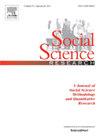1976-2017年,以色列移民对美国的选择性提高
IF 3.5
2区 社会学
Q1 SOCIOLOGY
引用次数: 0
摘要
移民的选择性很大程度上取决于技能的经济回报。自上世纪70年代以来,美国相对于以色列的收入差距不断扩大(这是美国技术回报更高的一个指标),意味着近几十年来,美国对以色列移民(尤其是高技能移民)的积极选择性有所加强。为了验证这一假设,我们将四个连续的以色列移民群体的教育和收入与两个基准群体——移民来自的以色列人口和移民加入的美国人口——进行了比较。基于对1980年、1990年、2000年和2015年以色列劳动力调查和美国人口普查数据的分析,结果支持了这一假设:“最近”以色列出生的犹太移民(在美国居住不超过5年的人)和以色列出生的犹太人口之间的教育水平差距随着时间的推移越来越大。相对于美国基准群体的收入分析(包括收入比率和五分位数回归)表明,连续几代以色列移民在美国的劳动力市场技能有所提高,不仅在教育方面,而且在一些未被观察到的、能提高收入的特征上也有所提高。此外,正如该理论所预期的那样,以色列移民的连续队列的选择性上升在最熟练的移民中是最大的,这些移民位于其队列收入分配的第90百分位数,并渴望加入美国收入最高的人群。本文章由计算机程序翻译,如有差异,请以英文原文为准。
Rising selectivity of Israeli immigrants to the United States, 1976–2017
The selectivity of immigrants largely depends on economic returns to skills. Since the 1970s the rising income inequality in the US relative to Israel, an indicator of greater returns to skills in the former, implies the intensification of the positive selectivity of Israeli immigrants in the US in recent decades, especially among the highly skilled. To test this hypothesis, we compared the education and income of four successive cohorts of Israeli immigrants relative to two benchmark groups—the Israeli population from which immigrants were drawn and the US population they joined. The results, based on analyzing Israeli Labor Force Surveys and US Census and ACS data from 1980, 1990, 2000, and 2015, support the hypothesis: the gaps in educational levels between successive cohorts of ‘recent’ Israeli-born Jewish immigrants (those who resided in the US for no more than 5 years) and the Israel-born Jewish population from which they were drawn, grew larger over time. Income analyses relative to US benchmark groups, both income ratios and quintile regressions, suggest that the labor market skills of successive cohorts of Israeli immigrants in the US have improved, not only on education, but also on some unobserved traits enhancing income. Moreover, as expected by the theory, the rise in the selectivity of successive cohorts of Israeli immigrants was the greatest among the most skilled immigrants—those located at the 90th percentile of their cohort's income distribution and aspiring to join the very top of income receivers in the US.
求助全文
通过发布文献求助,成功后即可免费获取论文全文。
去求助
来源期刊

Social Science Research
SOCIOLOGY-
CiteScore
4.30
自引率
4.00%
发文量
0
审稿时长
65 days
期刊介绍:
Social Science Research publishes papers devoted to quantitative social science research and methodology. The journal features articles that illustrate the use of quantitative methods in the empirical solution of substantive problems, and emphasizes those concerned with issues or methods that cut across traditional disciplinary lines. Special attention is given to methods that have been used by only one particular social science discipline, but that may have application to a broader range of areas.
 求助内容:
求助内容: 应助结果提醒方式:
应助结果提醒方式:


